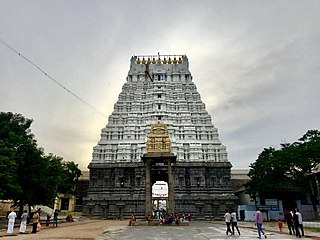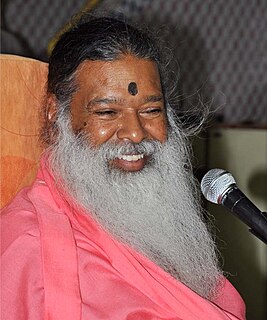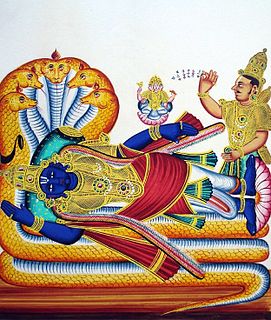
Māri, also known as Mariamman and Mariaai, spelt also Maariamma, or simply Amman or Aatha ("mother") is the South Indian Hindu goddess of rain. She is the main South Indian mother goddess, predominant in the rural areas of Tamil Nadu and Karnataka. Māri is related with the Hindu goddesses Parvati and Durga as well as with her North Indian counterpart Shitala Devi.

Badrinath is a holy town and a nagar panchayat in Chamoli district in the state of Uttarakhand, India. It is one of the four sites in India's Char Dham pilgrimage and gets its name from the Badrinath Temple.

Sivananda Saraswati was a Hindu spiritual teacher and a proponent of Yoga and Vedanta. Sivananda was born Kuppuswami in Pattamadai, in the Tirunelveli district of Tamil Nadu. He studied medicine and served in British Malaya as a physician for several years before taking up monasticism. He lived most of his life near Muni Ki Reti, Rishikesh.

Kanchipuram, also known as Kānchi or Kancheepuram, is a temple city in the Indian state of Tamil Nadu in Tondaimandalam region, 72 km (45 mi) from Chennai – the capital of Tamil Nadu. The city covers an area of 11.605 km2 (4.481 sq mi) and had a population of 164,265 in 2011. It is the administrative headquarters of Kanchipuram District. Kanchipuram is well-connected by road and rail.

Vasishtha is one of the oldest and most revered Vedic rishis. He is one of the Saptarishis of India. Vashistha is credited as the chief author of Mandala 7 of the Rigveda. Vashishtha and his family are mentioned in Rigvedic verse 10.167.4, other Rigvedic mandalas and in many Vedic texts. His ideas have been influential and he was called the first sage of the Vedanta school of Hindu philosophy by Adi Shankara.

Ganga is the personification of the river Ganga, and is worshiped by Hindus as the goddess of purification and forgiveness. Known by many names, Ganga is often depicted as a beautiful fair woman, riding a divine creature called Makara. Some of the earliest mentions of Ganga are found in the Rigveda, where she is mentioned as the holiest of rivers.

Varadharaja Perumal Temple or Hastagiri or Attiyuran is a Hindu temple dedicated to Lord Vishnu located in the holy city of Kanchipuram, Tamil Nadu, India. It is one of the Divya Desams, the 108 temples of Vishnu believed to have been visited by the 12 poet saints, or Alwars. It is located in a suburb of Kanchipuram known as the Vishnu Kanchi that is a home for many famous Vishnu temples. One of the greatest Hindu scholars of Vaishnava Vishishtadvaita philosophy, Ramanuja is believed to have resided in this temple. The temple along with Ekambareswarar Temple and Kamakshi Amman Temple in Kanchipuram is popularly known as Mumurtivasam, while Srirangam is referred to as: 'Koil' and Tirupati as: 'Malai'. Among the Divya Desams, Kanchipuram Varadaraja Perumal temple is known as: 'Perumal Koil'. This is one of the most sacred places for Vaishnavites. The fourth of the Divya Desams that completes this series is Melukote—which is known as Thirunarayanapuram. Vaishnavites believe that visiting all four places without a break will guarantee one a place in paramapadam.

Nimishamba is the name of a temple on the banks of the Cauvery river, located about 2 km from Srirangapattana on the road leading to Sangam (confluence) in the south Indian state of Karnataka.

Sri Ganapathi Sachchidananda Swamiji, popularly known as His Holiness Sri Sri Ganapathy Sachchidananda Swamiji, is a Hindu avadhuta known for his healing abilities.

Sri Vaishnava Sampradaya or Sri Vaishnavism is a denomination within the Vaishnavism tradition of Hinduism. The name is derived from Sri referring to goddess Lakshmi as well as a prefix that means "sacred, revered", and god Vishnu who are together revered in this tradition.

Thiruvangad Sree Ramaswami temple is an important temple located in the east part of Thalassery. The temple is generally known as the Brass Pagoda from the copper sheeting of its roof. A part of the temple was damaged by Tipu Sultan's troops in the 18th century, but the temple itself is believed to have been saved from destruction. It was one of the outposts of the Thalassery fort in the eighteenth century. In its precincts were held many conferences between the officials of the East India Company and local leaders, at which political treaties and agreements were signed. The temple contains some interesting sculptures and lithic records. The annual festival of temple commences on Vishu day in Medam (April–May) and lasts for seven days.

Vishnu Puran is an Indian television series, by B. R. Chopra on the Hindu deity Vishnu. It is based on the Vishnu Purana. Vishnu Puran tells about the 10 incarnations of Vishnu, as well as other stories, such as the legend of Dhruva. The weekly series first aired Sunday morning, January 23, 2000 on Zee TV. The 125 episodes were later released on DD National.

Devaadi Raja Perumal temple (தேவாதிராஜன்) in Therazhundur, a village in Mayiladuthurai district of the South Indian state of Tamil Nadu, is dedicated to the Hindu god Vishnu. Constructed in the Dravidian style of architecture, the temple is glorified in the Divya Prabandha, the early medieval Tamil canon of the Azhwar saints from the 6th–9th centuries AD. It is one of the 108 Divyadesam dedicated to Vishnu, who is worshipped as Amaruviappan and his consort Lakshmi as Sengamalavalli Thayar. The original structure of the temple was built by the Karikala Chola during the 1st century CE, with later additions from the Cholas during the 11th century.

Hara Saabha Vimochana Perumal Temple in Thirukandiyur, a village in the outskirts of Thiruvayaru in the South Indian state of Tamil Nadu, is dedicated to the Hindu god Vishnu. Constructed in the Dravidian style of architecture, the temple is glorified in the Divya Prabandha, the early medieval Tamil canon of the Azhwar saints from the 6th–9th centuries AD. It is one of the 108 Divyadesam dedicated to Vishnu, who is worshipped as Hara Saabha Vimochana and his consort Lakshmi as Kamalavalli.

Pancharanga Kshetrams or Pancharangams is a group of five sacred Hindu temples, dedicated to Ranganatha, a form of the God Vishnu, on the banks of the Kaveri River. The five Pancharanga Kshetrams in the order of their successive locations, on the banks of the Kaveri River are: The Srirangapatna called the Adi Rangam, the first temple on the banks of the Kaveri River from the upstream side; the Srirangam in Tamil Nadu known as Kasthuri Rangam or Anthya Rangam, Appalarangam or Koviladi at Tiurppernagar in Tamil Nadu, Parimala Ranganatha Perumal Temple at Tiruindalur in Mayiladuthurai or Mayuram and Vatarangam near Sirkazhi, also listed as Sri Renganatha Perumal Temple, Vadarengam, Tamil Nadu, 609108.

Narasingam is a village located 8 km from Madurai on the road to Melur, in the Indian state of Tamil Nadu. It is named for the nearby cave temple dedicated to Yoga Narasimha Perumal, at the foot of the Yanaimalai hills. This temple was constructed in 770 A.D. by Madurakavi alias Marankaari who was the minister of the Madurai King Parantaka Nedunjadaiyan. There is a front mandapam (court). The sculpture of Narasinga Perumal is carved out of the hill itself. The temple is a good example of the cave sculpturing of the Pandya Kingdom. In front of this there is a stone temple for the goddess Narasingavalli. This place, though not a Divyadesam sanctified by Azhwars' hymns, is situated between two holy places — Alagar Koyil in the north and Thirumohur in the east.

The Advaita Guru-Paramparā is the traditional list (parampara) of divine, Vedic and historical teachers of Advaita Vedanta. It begins with the Daiva-paramparā, the gods; followed by the Ṛṣi-paramparā, the Vedic seers; and then the Mānava-paramparā, with the historical teachers Gaudapada and Shankara, and four of Shankara's pupils. Of the five contemporary acharyas, the heads of the five Advaita mathas, four acharyas trace their lineage to those four pupils and one to Adi Shankara himself.

The Saranathan Temple in Thirucherai, a village in the outskirts of Kumbakonam in the South Indian state of Tamil Nadu, is dedicated to the Hindu god Vishnu. The temple is glorified in the Divya Prabandha, the early medieval Tamil canon of the Azhwar saints from the 6th–9th centuries AD. It is one of the 108 Divyadesam dedicated to Vishnu, who is worshipped as Saranathan and his consort Lakshmi as Saranayaki. It is believed that Saranathan appeared for Cauvery, the river goddess, who performed penance at this place.

Betrayaswamy temple in Denkanikottai town in Krishnagiri district in the South Indian state of Tamil Nadu, is dedicated to the Hindu god Vishnu. It is located 22 km from Hosur and 60 km from Bangalore. Constructed in the Hoysala style of architecture, the temple is dedicated to Vishnu who is worshipped as Devaperumal and his consort Lakshmi as Soundaryavalli in this temple.

Venkateswara Temple is a Vaishnavite temple situated in the town of Dwaraka Tirumala of West Godavari district of the Indian state of Andhra Pradesh. The temple is dedicated to Lord Venkateswara, an incarnation of Vishnu. The temple is also known by other name like Chinna Tirupati meaning Small Tirupati.





















